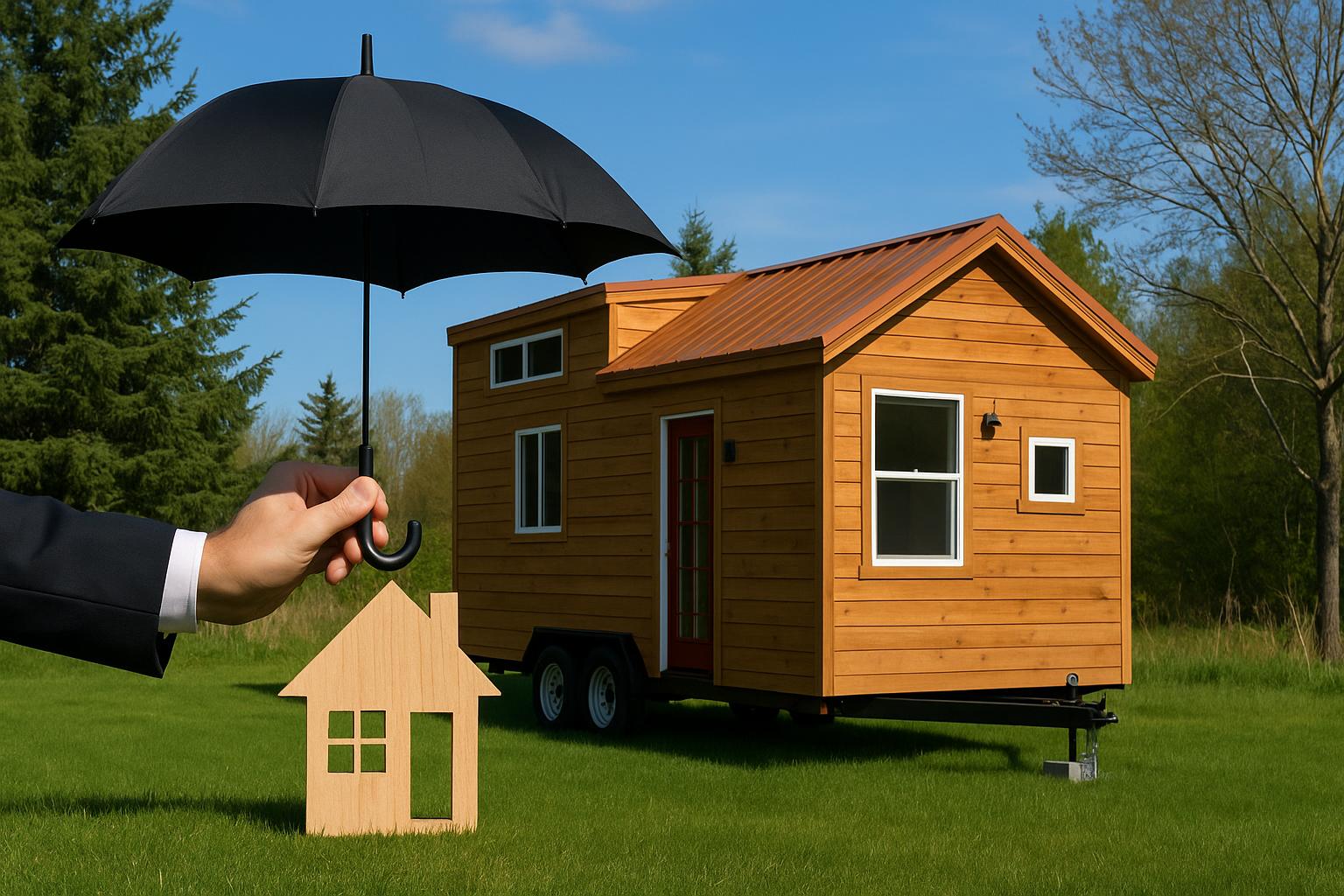
Tiny Home Insurance Canada: Your Detailed Guide to Coverage for Tiny Homes & ADUs in 2025
Estimated reading time: 8 minutes
Key Takeaways
- Specialized Coverage: Tiny home insurance is tailored to protect non-traditional, compact dwellings and ADUs against unique risks.
- ADU Importance: ADUs require dedicated coverage to safeguard against property damage, liability, and loss of rental income.
- Provider Trends: Leading Canadian providers are evolving their offerings to include policies for off-grid, mobile, and self-built homes.
- Customization & Flexibility: Review exclusion clauses, add-ons and ensure documentation to meet your specific housing needs.
- Stay Informed: Ongoing changes in zoning, building codes, and technology mean that annual reviews of your policy are essential.
Table of Contents
- Introduction: Why Tiny Home Insurance Canada Is Essential for 2025
- Understanding Tiny Home Insurance in Canada
- ADU Coverage: What It Is and Why It Matters
- Top Canadian Providers for Tiny Home Insurance in 2025
- What to Look for in the Best Insurance for Tiny Homes in 2025
- Tips for Getting the Right Tiny Home Protection
- Conclusion
- Frequently Asked Questions
Introduction: Why Tiny Home Insurance Canada Is Essential for 2025
Tiny home insurance Canada is a growing need as more Canadians embrace innovative living solutions like tiny homes and ADUs (Accessory Dwelling Units). Unlike traditional housing, tiny homes are typically between 100 and 400 square feet—compact, efficient, and often custom-built or mobile. ADUs, such as backyard suites or garage apartments, offer similar flexibility.
Interest in these housing options is surging, thanks to rising house prices, changing zoning laws, and the increased push for affordable alternatives. According to recent studies, the tiny house movement is no longer a niche but a fast-growing sector in Canada (Rates.ca, ThinkInsure, Aviva).
This guide will break down:
- What tiny home insurance is and how it differs from standard coverage
- Why ADU coverage matters
- Leading Canadian providers for 2025
- Practical steps to find the best insurance 2025 for your tiny home or ADU
For insights on designing and living in tiny homes efficiently, see our guide on Tiny Home Living: Your Complete Guide to Micro Homes, Sustainability, and Lifestyle Freedom.
Sources:
Rates.ca,
ThinkInsure,
Aviva,
isure.ca
Understanding Tiny Home Insurance in Canada
What Is Tiny Home Insurance?
Tiny home insurance in Canada is tailored to protect small, non-traditional dwellings—whether stationary or mobile—against risks like fire, theft, weather damage, liability claims, and loss of personal belongings.
Key Features of Tiny Home Insurance:
- Structure Protection: Covers your home against fire, severe weather, or theft (Tiny House Alliance USA).
- Personal Belongings Coverage: Insures furniture, electronics, and valuables inside the home.
- Liability Coverage: Protects you if someone is hurt on your property or if your home damages someone else’s property.
For design and safety tips that complement your insurance, check out Tiny Home Design in Canada: Expert Tips for Maximizing Small Living Spaces.
How Tiny Home Insurance Differs from Traditional Coverage:
Traditional home insurance often excludes or doesn’t fit the needs of tiny homes because of several unique features:
-
Mobility:
- Stationary tiny homes are built on a permanent foundation, while mobile units are built on trailers or are RV-certified.
- Insurance must match the home’s mobility status, with special policies for towable or on-wheels homes (Rates.ca, ThinkInsure).
-
Construction Methods:
- Many tiny homes use unconventional or recycled materials; some are self-built or converted shipping containers.
- Insurers need to evaluate risk differently than for conventional builds (isure.ca, see also Reclaimed Materials: The Eco-Friendly and Budget-Friendly Guide to Building Canadian Tiny Homes).
-
Building Standards:
- Not all tiny homes meet local or national building codes, which can affect eligibility for traditional insurance.
- Many insurers look for CSA or equivalent certification (Aviva, also see Tiny Home Certification in Canada: How to Achieve Compliance and Safety in 2025).
Why Standard Policies Aren’t Enough
Regular home insurance often will not cover dwellings below a certain size or lacking standard features. Tiny homes may be classified as mobile or manufactured homes, modular houses, or even RVs—each with its own specific insurance requirements and price points. Exclusions for mobility, off-grid utilities, or custom-built features can lead to huge coverage gaps if not addressed (isure.ca, Aviva).
Suppose your home moves, has solar panels, or is partially off-grid—these factors must be disclosed and specifically covered to avoid denied claims. For more on solar and off-grid systems, see Tiny Home Utilities Canada: Comparing On-Grid vs Off-Grid Systems and Exploring Innovative Utility Solutions for Sustainable Living.
Sources:
Rates.ca,
ThinkInsure,
Tiny House Alliance USA,
isure.ca,
Aviva
ADU Coverage: What It Is and Why It Matters
Understanding ADUs (Accessory Dwelling Units)
An ADU is a small, independent living space built on the same lot as the main house. Common types include:
- Garden Suites: Freestanding mini-houses in the backyard.
- Garage Apartments: Living quarters built above or beside a garage.
- Basement Suites: Self-contained rental spaces in a primary residence.
For more on accessory dwelling units, see Accessory Dwelling Units: The Ultimate Guide to ADUs for Canadian Property Investment.
What Is ADU Coverage?
ADU coverage ensures that the accessory unit is protected against property damage (fire, weather, vandalism), liability (injuries or accidents involving guests or tenants), and loss of rental income (if the ADU becomes uninhabitable).
Policy Structures:
- Extension From Primary Policy: Some homeowner policies cover attached ADUs if they are part of the main structure.
- Specialized ADU Policy: Required for detached, standalone ADUs or those with unique utilities.
Distinctive ADU Risks:
- Rental Liability: Renting out an ADU adds exposure, requiring landlord liability.
- Separate Utilities: Insuring features like meters, heating, or solar panels specific to the ADU.
- Rental Income Protection: If a covered loss makes your ADU unlivable, income loss can be covered.
Overlap with tiny home insurance is frequent—especially if you use a tiny home as your ADU. Ensure you check all occupancy types, coverage limits, and exclusions to avoid coverage gaps for your structure or situation. Learn more at Understanding ADU Insurance Canada: A Complete Guide to Protecting Your Home and Tiny Home Investments.
Source: ThinkInsure
Top Canadian Providers for Tiny Home Insurance in 2025
Canadian Providers and 2025 Insurance Trends
For 2025, more Canadian providers are adapting to the needs of tiny houses and ADUs. The market is changing fast thanks to evolving regulations, the rise of mobile and off-grid homes, and increased consumer demand for custom coverage.
Leading Providers:
-
Aviva Canada
- Recognized leader in tiny house coverage.
- Offers insurance if your home is CSA-certified and built to code.
- Covers both stationary and permanent setups.
- Frequently updates options to keep pace with the tiny home movement (Aviva).
-
Specialty Brokers/Local Insurance Providers
- Many major insurers don’t directly offer tiny home insurance.
- Brokers on Rates.ca and ThinkInsure work with niche carriers that understand the unique needs of off-grid, mobile, and self-built units.
-
Comparison Platforms (e.g., Rates.ca, ThinkInsure)
- Ideal for comparing quotes, coverage, and add-ons.
- They connect you with brokers experienced in custom dwellings.
Key Things to Compare:
- Policy Features: Coverage for fire, storm, liability, and theft.
- Self-Built Acceptance: Whether the provider insures DIY builds or unconventional constructions.
- Mobility Options: Coverage specifics for permanent vs mobile dwellings.
- Customer Service: Reviews and claims process ratings.
- Affordability: Pricing ranging from approximately $400 to $1,500+ annually (ThinkInsure).
2025 Trends to Watch
- Greater acceptance of non-traditional builds as zoning changes.
- Increased requirements for CSA or similar certifications (Aviva).
- Enhanced policies including mobility insurance, extended theft coverage, and add-ons for solar or smart tech (Tiny House Alliance USA).
Sources:
Aviva,
ThinkInsure,
Rates.ca,
Tiny House Alliance USA
What to Look for in the Best Insurance for Tiny Homes in 2025
How to Choose the Best Insurance 2025
Choosing the best insurance 2025 for your tiny home or ADU means carefully evaluating several key criteria:
-
Comprehensive Coverage:
- Protection for structure, contents, and liability.
- Extra protection including travel and mobile unit considerations.
-
Affordability:
- Balance premium costs with the replacement value and risks.
-
Flexibility & Customization:
- Options for off-grid setups, such as solar or composting toilets (Composting Toilets: The Ultimate Waste Management Solution for Tiny Homes in Canada).
-
Experience & Reputation:
- Providers that understand non-traditional housing and have strong customer reviews.
-
Exclusion Clauses and Add-Ons:
- Clarify what is not covered and evaluate additional riders for transit, wildfire, or flooding risks.
Comparing these features side-by-side will help ensure you secure the best insurance for 2025 and true protection for your tiny home.
Tips for Getting the Right Tiny Home Protection
Practical Steps Toward Full Tiny Home Insurance
-
Prepare All Documentation:
- Keep architectural plans, receipts, permits, and CSA certifications handy.
- Document all materials and unique features of your build (Rates.ca, ThinkInsure, Aviva).
-
Organize Detailed Photos:
- Capture clear images of exterior areas, interior rooms, and any custom features such as solar panels or smart storage.
-
Understand Exclusions and Riders:
- Discuss with your broker any hazards not covered by the standard policy, especially for mobile dwellings (Tiny House Alliance USA).
-
Stay Updated on Regulations:
- Review local zoning and building codes periodically to ensure compliance (ThinkInsure, Aviva).
-
Communicate Clearly with Insurers:
- Be transparent about your home’s use, whether primary, rental, or seasonal, including off-grid features.
Follow this checklist each time you review or purchase tiny home protection. For additional tips on DIY builds, see DIY Tiny Home Canada: Essential Finishing Construction Tips to Avoid Homebuilding Pitfalls.
Sources:
Rates.ca,
ThinkInsure,
Aviva,
Tiny House Alliance USA
Conclusion
Having the right tiny home insurance Canada coverage is essential if you own or rent a tiny home or ADU. As more Canadians choose creative living options, insurance providers are crafting tailored, flexible policies to meet these unique needs.
Key takeaways:
- Specialized Canadian providers now offer policies for mobile, off-grid, and self-built tiny homes and ADUs.
- ADU coverage is crucial given its unique liability risks and rental income considerations.
- The best insurance policies for 2025 address niche needs, cover multiple risk factors, and evolve with changing regulations.
Do not rely on traditional home insurance—review your options annually and opt for tailored, state-of-the-art protection. For legal and certification insights, see Tiny Home Legal Requirements Canada: A Comprehensive Guide for Buyers to Navigate Laws, CSA Certification, Titles, and Insurance.
Sources:
ThinkInsure,
isure.ca,
Aviva
Frequently Asked Questions
1. What makes tiny home insurance different from traditional home insurance?
Traditional home insurance policies are designed for standard houses and often do not cover the unique features of tiny homes such as off-grid systems, mobile structures, or custom-built designs. Tiny home insurance is tailored to address these specific risks.
2. Do I need a separate policy for my ADU?
It depends on your primary policy. Some insurers extend coverage to ADUs attached to your main home; however, detached or uniquely configured ADUs might require a specialized policy.
3. How can I ensure my self-built tiny home meets insurance requirements?
Maintaining thorough documentation such as architectural plans, receipts, and CSA or local certification is key. Always discuss the specifics with your insurer to ensure all aspects are covered.
4. Are there additional riders available for mobile tiny homes?
Yes, many providers offer extra riders to cover transit risks, theft while moving, and other challenges specific to mobile homes.
If you have further questions about tiny home or ADU insurance, feel free to leave a comment or reach out to an insurance expert for guidance.

Leave a Reply